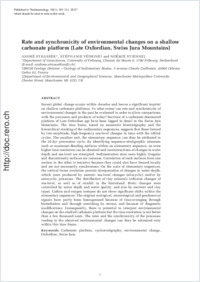Rate and synchronicity of environmental changes on a shallow carbonate platform (Late Oxfordian, Swiss Jura Mountains)
- Strasser, André Department of Geosciences, University of Fribourg, Switzerland
- Védrine, Stéphanie BRGM Geology Division – Geology of Sedimentary Basins, Orléans, France
- Stienne, Noémie Department of Environmental and Geographical Sciences, Manchester Metropolitan University, UK
-
12.05.2011
Published in:
- Sedimentology. - 2012, vol. 59, no. 1, p. 185–211
English
Recent global change occurs within decades and leaves a significant imprint on shallow carbonate platforms. To what extent can rate and synchronicity of environmental changes in the past be evaluated in order to allow comparisons with the processes and products of today? Sections of a carbonate-dominated platform of Late Oxfordian age have been logged in detail in the Swiss Jura Mountains. The time frame, based on ammonite biostratigraphy and the hierarchical stacking of the sedimentary sequences, suggests that these formed by low-amplitude, high-frequency sea-level changes in tune with the orbital cycles. The smallest unit, the elementary sequence, can thus be attributed to the 20 kyr precession cycle. By identifying sequence-stratigraphic elements such as maximum-flooding surfaces within an elementary sequence, an even higher time resolution can be obtained and reconstructions of changes in water depth and sea-level are attempted. Sedimentation rates were highly irregular and discontinuity surfaces are common. Correlation of such surfaces from one section to the other is tentative because they could also have formed locally and are not necessarily synchronous. On the scale of elementary sequences, the vertical facies evolution permits interpretation of changes in water depth, which were produced by eustatic sea-level changes (allocyclic) and/or by autocyclic processes. The distribution of clay minerals indicates changes of sea-level, as well as of rainfall in the hinterland. Biotic changes were controlled by water depth and water quality, and also by nutrient and clay input. Carbon and oxygen isotopes do not show significant shifts within the elementary sequences. The original ecological, mineralogical and geochemical signals have partly been homogenized because of time-averaging through bioturbation and through reworking by storms, and because of diagenetic modifications. Consequently, there is potential to interpret environmental changes on the studied carbonate platform but the time resolution is not better than a few thousand years. The rates and the synchronicity of the processes leading to the observed environmental changes can thus be estimated only within this time frame.
- Faculty
- Faculté des sciences et de médecine
- Department
- Département de Géosciences
- Language
-
- English
- Classification
- Palaeontology
- License
- License undefined
- Identifiers
-
- RERO DOC 28755
- DOI 10.1111/j.1365-3091.2011.01236.x
- Persistent URL
- https://folia.unifr.ch/unifr/documents/302219
Statistics
Document views: 84
File downloads:
- str_rse.pdf: 250
